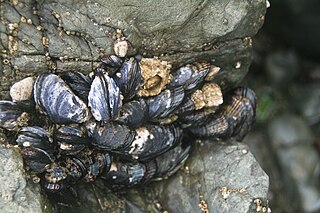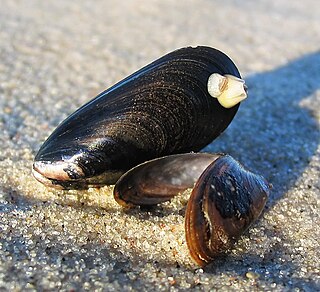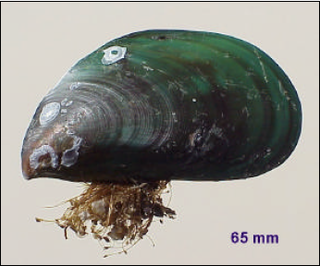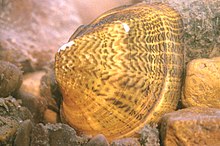
Mussel is the common name used for members of several families of bivalve molluscs, from saltwater and freshwater habitats. These groups have in common a shell whose outline is elongated and asymmetrical compared with other edible clams, which are often more or less rounded or oval.

Lake Powell is a man-made reservoir on the Colorado River in Utah and Arizona, United States. It is a major vacation spot visited by approximately two million people every year. It is the second largest man-made reservoir by maximum water capacity in the United States behind Lake Mead, storing 24,322,000 acre feet (3.0001×1010 m3) of water when full. However, due to high water withdrawals for human and agricultural consumption, and because of subsequent droughts in the area, Lake Mead has fallen below Lake Powell in size several times during the 21st century in terms of volume of water, depth and surface area.

A byssus is a bundle of filaments secreted by many species of bivalve mollusk that function to attach the mollusk to a solid surface. Species from several families of clams have a byssus, including the pen shells, the true mussels and the false mussels: the Pinnidae, the Mytilidae and the Dreissenidae.

The zebra mussel is a small freshwater mussel. The species was originally native to the lakes of southern Russia and Ukraine, but has been accidentally introduced to numerous other areas and has become an invasive species in many countries worldwide. Since the 1980s, the species has invaded the Great Lakes, Hudson River, and Lake Travis.

The blue mussel, also known as the common mussel, is a medium-sized edible marine bivalve mollusc in the family Mytilidae, the mussels. Blue mussels are subject to commercial use and intensive aquaculture. A species with a large range, empty shells are commonly found on beaches around the world.

Tide pools or rock pools are shallow pools of seawater that form on the rocky intertidal shore. Many of these pools exist as separate bodies of water only at low tide.

Perna canaliculus, the New Zealand green-lipped mussel, also known as the New Zealand mussel, the greenshell mussel, kuku, and kutai, is a bivalve mollusc in the family Mytilidae. P. canaliculus has economic importance as a cultivated species in New Zealand.

The Unionidae are a family of freshwater mussels, the largest in the order Unionida, the bivalve molluscs sometimes known as river mussels, or simply as unionids.

The freshwater pearl mussel is an endangered species of freshwater mussel, an aquatic bivalve mollusc in the family Margaritiferidae.

The California mussel is a large edible mussel, a marine bivalve mollusk in the family Mytilidae.

Mytilidae are a family of small to large saltwater mussels, marine bivalve molluscs in the order Mytilida. One of the genera, Limnoperna, inhabits brackish or freshwater environments. The order has only this one family which contains some 52 genera.

Unionida is a monophyletic order of freshwater mussels, aquatic bivalve molluscs. The order includes most of the larger freshwater mussels, including the freshwater pearl mussels. The most common families are the Unionidae and the Margaritiferidae. All have in common a larval stage that is temporarily parasitic on fish, nacreous shells, high in organic matter, that may crack upon drying out, and siphons too short to permit the animal to live deeply buried in sediment.

Perna viridis, known as the Asian green mussel, is an economically important mussel, a bivalve belonging to the family Mytilidae. It is harvested for food but is also known to harbor toxins and cause damage to submerged structures such as drainage pipes. It is native in the Asia-Pacific region but has been introduced in the Caribbean, and in the waters around Japan, North America, and South America.

Perna perna, the brown mussel, is an economically important mussel, a bivalve mollusc belonging to the family Mytilidae. It is harvested as a food source but is also known to harbor toxins and cause damage to marine structures. It is native to the waters of Africa, Europe, and South America and was introduced in the waters of North America.

Hillion is a commune in the Côtes-d'Armor department of Brittany in northwestern France.

Esnandes is a commune in the Charente-Maritime department in the Nouvelle-Aquitaine region in southwestern France. Its inhabitants are known as Esnandais.

Truncilla truncata, the deertoe, is a species of freshwater mussel, an aquatic bivalve mollusk in the family Unionidae.
Bryant Walker (1856–1936) was an American malacologist who specialized in the non-marine Mollusca. He mainly studied the freshwater mollusks of the USA, in particular those of Michigan. He published many papers on the Unionida, an order of freshwater mussels.

Stuffed mussels or Midye is a generic name for plump orange mussels, herbed and spiced rice, pine nuts, and occasionally currants. It is a popular and common street food snack in the coastal and other areas of Turkey such as Istanbul, İzmir and Bodrum. Midye dolma is sold at all hours and is normally eaten with lemon juice freshly squeezed over them so that the mussel and rice are not dry and the spices are easily mixed and tasted.
The Nore pearl mussel is a critically endangered species of freshwater pearl mussel, an aquatic bivalve mollusc in the family Margaritiferidae.


















